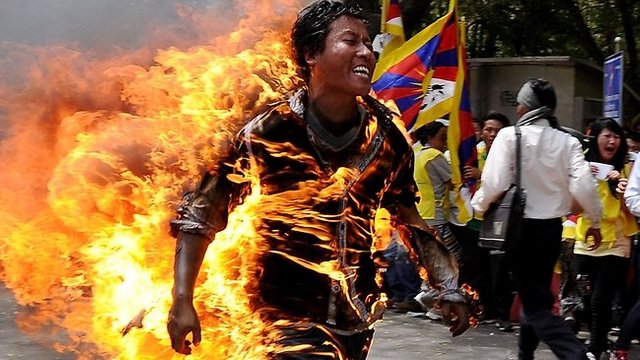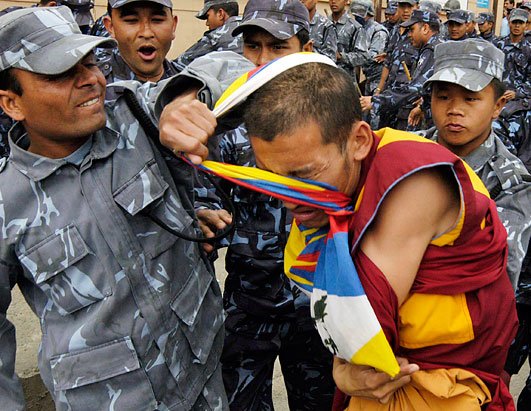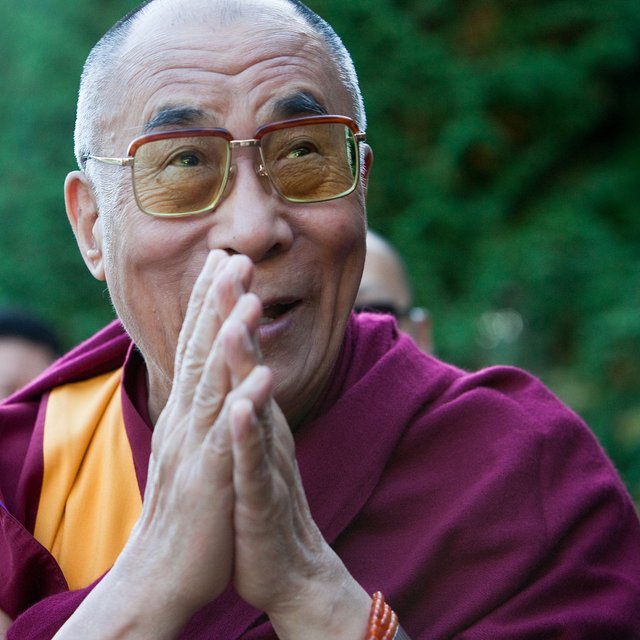A Conflict Series: Self-Immolation, Ethnic Hatred, and Cultural Destruction in Tibet
Introduction
Ever since China invaded Tibet in 1951 and wrested power from the hands of the national Tibetan government, Tibet has been a source of conflict for China. From CIA backed separatist movements in the 50's, to independence riots and protests in the late 80's, to the most recent resurgence of independence movements in 2008, Tibet has never rested easy under Communist Chinese rule. As a result, China, not necessarily known for its delicate handling of internal strife, has often retaliated violently through the use of the armed forces.
Main Issues
- History
The Chinese and Tibetans have completely different views on their history as a nation. The 1951 invasion of Tibet by the Chinese is seen by the Tibetans as just that, an invasion. However, the Chinese believe they were simply reclaiming lost land. This is because during several periods over the last 1000 years, Tibet has been part of the Chinese empire.
Chinese View: The Tibetans have not been entirely independent for hundreds of years, ever since they were conquered by the Mongols. They believe that Tibet has been under Chinese "suzerainty" (a tribute state) since the 18th century. Further, Chinese believe that the only reason the Tibetans think they were independent was because the British purposefully bred the idea of an independent Tibet in order to create a buffer state between China and the British Raj in India.
Tibetan View: After the Xinhai Revolution that brought down the Qing Imperial Dynasty in 1910, the Tibetans escorted all Chinese troops out of Tibet and the Dalai Lama (the spiritual leader of Tibet) declared himself an independent ruler. From then until the Chinese invasion in 1951, they were an independent state.
Source
Source

Economic Growth
China claims that the $45.4 billion that it spent in the Tibet Autonomous Region between 1978 and 2003 helped make the region's GDP in 2003 more than 28 times bigger than in 1978. While it is true that Chinese control over Tibet has helped grow the economy enormously, there are two main issues that come from this growth.
Disparity Along Ethnic Lines: All this money that is flowing into Tibet from China and through Chinese economic growth policies is, by and large, flowing directly into the hands of Han Chinese immigrants. It is very difficult for young Tibetans to find jobs, and only a little more than 2% of shops or restaurants in Lhasa (the capital of Tibet) in 2010 were owned by Tibetans. Source
Sinicization: With the enforced economic growth of Chinese policy has come a fundamental undercutting and destruction of the traditional Tibetan way of life. As a result of Chinese political and economic policies, Tibetan Buddhism (an integral part of Tibetan life) has been heavily restricted, traditional agricultural methods have been abolished, and much of Tibet's unique fauna have been killed.
Source

A Monk in Ethnically Tibetan Gansu Self Immolates in Protest of the Chinese Communist Party - Source Lack of Self-Determination
While Tibet is nominally an autonomous region (thus the name Tibetan Autonomous Region), the reality is that all policies are strictly monitored by the Chinese Communist Party. For Tibetans, the only true ruler of the Tibetan nation can be the Dalai Lama, who has been in exile in India since 1959. However, there has been no way for the Dalai Lama to return to Tibet because the Chinese believe he is a separatist and a reactionary who can inflame the people to revolution. However, this is a fundamental misjudgment from the Chinese, and has really only helped to incite the Tibetan people to greater anti-Chinese anger.
SourceHuman Rights Violations
China has further perpetrated numerous human rights violations in Tibet, from torture to liberal use of the death penalty to extrajudicial killings. There is also a restriction on religious freedom and a tight control by the Chinese Communist Party over Tibetan media and freedom of speech.
Source Source
Police Violence in Tibet - Source
How to Solve It?
The important thing to note here is that there is a fundamental miscommunication between the Chinese and the Tibetans. The Chinese believe that they are only exercising their historical right to power over the region, while simultaneously ameliorating the standard of living in Tibet. Many Chinese do not understand why Tibetans are so angry with them. At the same time, the Chinese government thinks that the anger in Tibet comes from wanting total freedom, which is not necessarily the case. Tibetans by and large are angry because of the economic disparity along ethnic lines, as well as what they see as the destruction of their culture. It is not the rule of the Chinese they are so inherently against, but rather what that rule has signified so far. If the Chinese can
- Make economic gain more evenly distributed among all
- Give Tibet the autonomous power over the region it nominally already has and
- Allow the Dalai Lama to return to the country and allow him to oversee the revival and preservation of Tibetan culture
it is highly likely that at the very least a truce could be found between the Chinese and Tibetan governments. These could be the building blocks for better things, and greater cooperation, to come.

The 14th Dalai Lama - Source
Conclusion
The conflict in Tibet has its roots in real and legitimate grievances of poor governance that oppresses ethnic Tibetans along religious and cultural lines. However, both sides of the conflict have an invested stake in calming the unrest; the Chinese because ethnic unrest in Tibet helps feed unrest in other ethnic minority regions of China such as Xinjiang, and the Tibetans because the Chinese can legitimately help them build a stronger economy and place in the world. What is truly required is a bridge of trust to be built between Communist party leadership and the exile government of the Dalai Lama, upon which a foundation for a positive political building process can be built.
Sources
- https://www.theguardian.com/commentisfree/2009/mar/30/tibet-china
- http://www.bbc.com/news/world-asia-pacific-16689779
- http://www.beyondintractability.org/casestudy/stokes-tibet
- http://www.nytimes.com/2009/06/06/world/asia/06tibet.html?_r=2
- http://news.bbc.co.uk/2/shared/spl/hi/guides/456900/456954/html/nn1page1.stm
- http://www.newsweek.com/china-finally-realizes-how-badly-it-bungled-tibet-71141
- http://www.cfr.org/china/can-chinas-tibetan-crisis-resolved/p18707?breadcrumb=%2Fregion%2F278%2Ftibet
- http://www.tibetjustice.org/materials/un/un8annex2.1.html
Good article. But i highly doubt that the picture "Police violence in Tibet" is from Tibet. Looks more like from Nepal.
Glad you liked the article! Just out of curiosity, why do you think the picture is from Nepal? The site I found it cited it as from Tibet, although I suppose it could be wrong.
First the police does not look Tibetan at all. Second, google "pro tibetan protest kathmandu", the uniforms are exactly like Nepalese. Third the source link you posted contains "NEPAL" right in it.
You're absolutely right, glad you caught that! My apologies, it is a pro-Tibetan rally in Nepal.